Technological Development
Establishment of Domestic Technologies
The path the development of technology took from the beginning of the business to the present day and the Toyota models that represent each phase are exhibited in this section. The past and present of automobile technologies are displayed in a multi-dimensionally comparative manner, including material development technology, design technology, and testing and evaluation technology. Technological advancement can be understood in one glance. You can thoroughly learn about an automobile by dissecting the many technologies applied in one car.
Toyota Automobiles that Represent the Era
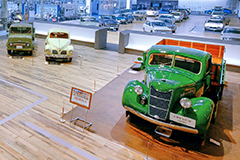
Toyota models that represent each stage of the business are lined up, from Toyota’s first passenger car and truck to the latest Progrès. Toyota has pursued popularization, higher speed, comfort, fuel-efficiency, and, now, environmental conservation. Varying needs arose as society changed, and each generation of automobiles was created in response to those needs. Awoken from their sleep in history, these models were refurbished to come alive again. They will remind you of the good old days, for those who know the past, and give a fresh sense of wonder to those who are seeing them for the first time.
Toyoda Type AA Passenger Car (1936 – Replica)
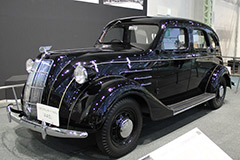
Kiichiro Toyoda aimed to establish domestic technology to realize mass production. The Type AA had an aerodynamic design that was epoch-making at the time but in a novel style that suits the sense of the current days. The number of Type AA produced is 1,404. The technology established in the manufacturing of this model became the foundation that supported the subsequent automobile industry.
The first-generation Toyota Crown (launched in 1955)
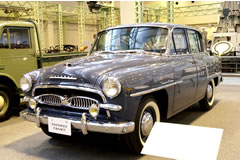
The automobile production was deregulated in 1949, and the development of automobiles that was in the national sentiment began proceeding at full tilt. The first-generation Crown was the forerunner in such effort and is the very first passenger car in its real sense that Toyota developed with its own, purely domestic technology. The model possessed the jaunty design in the American style, the unique casement doors, and robust footwork that gave comfort in riding with the top speed of 100 km/hr. The car was put to the test for the challenge of a “London – Tokyo 50,000 km” run and succeeded in 1956.
Changes in Material Technology
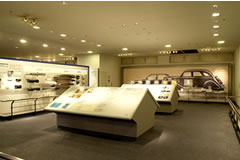
Automobile parts are made of various materials: metals such as iron, copper, and aluminum, as well as non-metals such as plastics, glass, and rubber. The changes in the materials used in automobile manufacturing are presented by comparing the materials in the Type AA passenger car and those in the current Celcior. The highlight is also placed, on the recycling technology, to protect the limited resource and the global environment.
Changes in the Technological Development
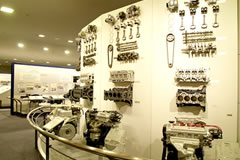
Many of the Japanese automobile manufacturers cooperated, with foreign manufacturers, to introduce technology and manufacture under license, after the Second World War. However, Toyota pursued the establishment of domestic technology and completed the first-generation Crown, based on its own planning and development, which matched the domestic conditions of the Japanese at that time. The changes in Toyota’s technological development, built from scratch through trial and error, are displayed.
Changes in Modeling Technology
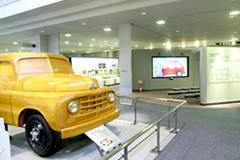
Modeling is a series of processes, from sketching and drawing to presenting 3-dimensional, reduced or full-scale prototypes. Toyota has continuously devised its own creative measures through trial and error as in the case where a prototype was built, with manually hammered steel sheets, in the beginning. Various modeling techniques are shown by exhibiting a wooden 1:1 scale model and a 1:5 scale clay model of a truck in the 1950s.
The Video Section (How a Car is Made)
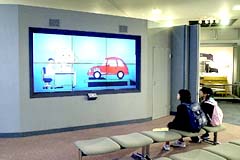
What processes are performed in the manufacturing of a new car? Toyota’s new product development is explained in an easy-to-understand manner, using animation videos. You can see the flow of work, from the formation of a project team that surrounds a chief engineer up to the point wherein the production begins, based on the product plan for a new model.
Technological Development
Automobiles have become widespread in society as indispensable for the transportation of people and the movement of goods. Toyota worked on technological development to answer to social issues such as safety measures, exhaust gas emission regulation, and resource- and energy-saving measures. The needs of people further diversified and increased in sophistication and complication in the 1980s. The technological development of Toyota, which aims for automobile manufacturing that harmonizes with people and their society while observing the world market, is illustrated in this section.
Toyota Automobiles 1960 – 2000
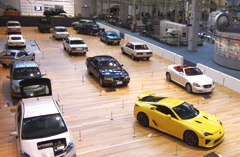
Here, you can see Toyota’s most well-known models that came along with the advancement of motorization in Japan. The first-generation Corolla was the forerunner at the dawn of the “my car” age. The first-generation Camry responded to the need for improved safety measures, exhaust emission control, and fuel efficiency. The first-generation Celcior (Lexus) received a high evaluation even abroad because of its excellent performance and quality.
The first-generation Toyota Corolla (launched in 1966)
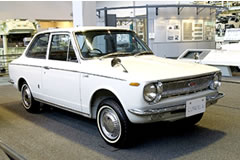
This model was developed based on the concept of a family car that shows excellent performance at high speed and that can have a place in the world market. It was a precursor to the “My Car” age in Japan. This model received a high evaluation from the family segment in every aspect such as performance, comfort, maintenance, and price.
The first-generation Celcior (launched in 1989)
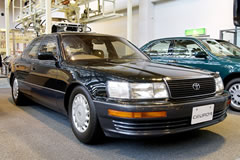
Self-regulation in automobile exports to the U.S. began as the US-Japan trade imbalance expanded in the 1980s. In correspondence to such circumstances, while on-site production overseas was being furthered, the Celcior came on the market as a high-performing, high-quality car that could receive high evaluations in the global market.
Changes in Evaluation Technology
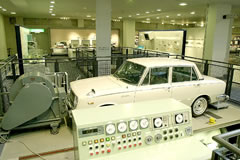
You cannot discuss the improvement in automobile roadworthiness without talking about the advancement in evaluation technology based on test courses. Although public roads were used in testing in the beginning, evaluation technology has greatly contributed to the manufacturing of reliable cars by evaluating comfort in riding, operation stability, vibration and noise in operation and brake performance. Samples of the roads in the world and a chassis dynamometer that operates with the press of a button are displayed.
Changes in Safety Technology
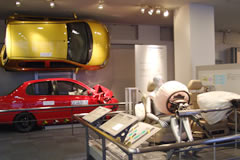
To protect people from an automobile accident, preventive safety technology that prevents an accident from happening and damage mitigating technology that protects people from an accident if one happened are both important. Technologies to ensure the range of vision and visibility, which are a safety test car “Toyota ESV,” a dummy doll, a crash test car, a seatbelt, and an airbag, are on display.
Changes in Fuel Efficiency Technology
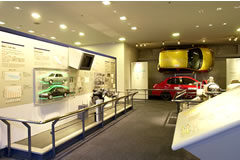
The automobile fuel efficiency is now one of the important themes. Various technologies to attain fuel efficiency, including those in weight-saving from the structural, design, and materials aspects, those to reduce aerodynamic resistance by design, and improvement in tires to control rolling resistance, are explained.
Changes in Exhaust Gas Reduction Technology
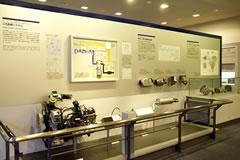
Automobile exhaust gas reduction technology made a big progress in the 1970s. The mechanism in exhaust gas reduction technology, an oxidation catalyst system, and a three-way catalyst system that are essential in manufacturing automobiles that are ecological to humans and global environment are explained in detail. Various catalytic converters are exhibited, as well.
Changes in Interior Environment
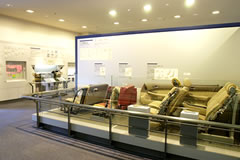
Comfort in driving is important, but I want to be particular about comfort in riding. Such needs heightened as technologies advanced. Technologies that evolved through repeated improvements in search of a more comfortable interior environment, such as functional seats that are appropriate in driving, the interior where vibration and noise are reduced, the operability of air-conditioner or audio equipment, are exhibited.
New Motive Power
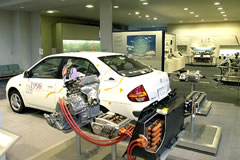
Roadability is as good as that of a traditional engine but clean and fuel-efficient. Seeking the way to the manufacturing of such a dream car, development in new motive power sources is in progress at Toyota. An advanced technology is explained, and a hybrid gas turbine engine and a methanol engine are displayed. A full-scale car of a hybrid model Prius is exhibited, and Toyota’s hybrid system is explained in an easy-to-understand manner.

